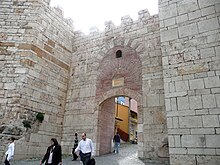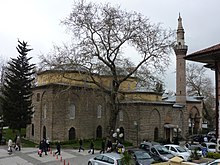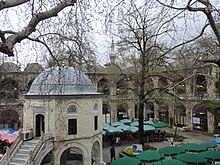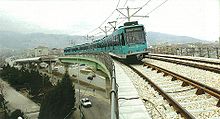Bursa
| Bursa | ||||
|
||||

|
||||
| Basic data | ||||
|---|---|---|---|---|
| Province (il) : | Bursa | |||
| Coordinates : | 40 ° 11 ' N , 29 ° 4' E | |||
| Height : | 100 m | |||
| Residents : | 3,056,120 (2019) | |||
| Telephone code : | (+90) 224 | |||
| Postal code : | 16,000 | |||
| License plate : | 16 | |||
| Structure and administration (as of 2019) | ||||
| Mayor : | Alinur Aktaş ( AKP ) | |||
| Website: | ||||
Bursa (from Greek Προύσα Prousa ), formerly Prusa , with 3.05 million inhabitants (as of 2019) is the fourth largest city in Turkey and the capital of the province of Bursa in western Turkey.
geography
Bursa is 90 kilometers south of Istanbul at the foot of the Uludağ Mountains, which used to be called the Bithynian Olympus . All around is a very green landscape with some medicinal sulfur springs . The coast of the Marmara Sea is 20 km away with the Gemlik Bay and 32 km with the town of Mudanya .
population
Results of censuses and population updates
The following tables show the documented population of the city of Bursa .
- The values in the table on the left are based on e-books (the original documents).
- The values in the table on the right come from the update by the addressable population register (ADNKS) introduced in 2007. They can be called up by a data query from the Turkish Statistics Institute TÜIK
| year | Population on censor day | ||
|---|---|---|---|
| total | male | Female | |
| 1927 | 61,451 | 30,508 | 30,943 |
| 1935 | 72,270 | 35,389 | 36,881 |
| 1940 | 77,598 | 36,968 | 40,630 |
| 1945 | 85,919 | 42,972 | 42,992 |
| 1950 | 103.812 | not specified ! | |
| 1955 | 128,875 | 64,795 | 64,080 |
| 1960 | 153,866 | 77,956 | 75,910 |
| 1965 | 211,644 | 107,554 | 104.090 |
| 1970 | 275,953 | 140,439 | 135,514 |
| 1975 | 346.103 | 179,328 | 166,775 |
| 1980 | 445.113 | 226.818 | 218.295 |
| 1985 | 612.510 | 311,396 | 301.114 |
| 1990 | 983.991 | 498,638 | 485.353 |
| 2000 | 1,400,158 | 701.856 | 698.302 |
| year | Population at the end of the year | ||
|---|---|---|---|
| total | male | Female | |
| 2007 | 1,710,227 | 855.487 | 854.740 |
| 2008 | 1,738,928 | 869.837 | 869.091 |
| 2009 | 1,775,921 | 887.566 | 888.355 |
| 2010 | 1,821,913 | 909.408 | 912.505 |
| 2011 | 1,862,093 | 931,350 | 930.743 |
| 2012 | 1,895,323 | 948.632 | 946.691 |
| 2013 | 1,938,521 | 971.006 | 967.515 |
| 2014 | 1,975,516 | 989.204 | 986.312 |
| 2015 | 2,019,573 | 1,012,238 | 1,007,335 |
| 2016 | 2,066,421 | 1,036,948 | 1,029,473 |
| 2017 | 2,091,331 | 1,047,854 | 1,043,477 |
| 2018 | 2.130.032 | 1,066,627 | 1,063,405 |
After the province of Bursa was granted the status of a metropolitan municipality in 1987 by law No. 3391 (enacted on June 18, 1987), the actual core city was divided into seven districts. The values shown from 1990 onwards were determined by adding up these seven city districts.
history
The city was called Prusa or Prusa ad Olympum in antiquity and was founded in 188/7 BC. Founded by King Prusias I of Bithynia .
Since 74 BC BC Prusa was part of the Roman province of Bithynia with all of Bithynia. In 257/8 the city was sacked by the Goths , around this time it was given a city wall. Prusa has been documented as a diocese since 325. In 350 Prusa was Vetranio's place of exile . In Byzantine times, Prusa was known for its thermal baths called Therma basilica in what is now the suburb of Çekirge, and emperors stayed there several times.
Bursa was the capital of the Ottoman Empire from 1326, when the sultan's son and later Sultan Orhan I conquered the city on April 6th . In 1368 the residence was moved to Edirne . In 1402 Bursa was devastated by the Mongols under Timur Lenk , and a large part of the Ottoman state treasure fell into their hands. The city flourished again under the government of Mehmet I (1413 to 1421). A great fire in 1801 and an earthquake in 1855 damaged parts of the city. After the First World War , Bursa was briefly occupied by France . In the summer of 1920 Greece conquered Bursa for about two years. After the defeat of the Greeks in the Greco-Turkish War in 1922, the city fell back to the Turks. The subsequent Turkish-Greek population exchange after the Treaty of Lausanne in 1923 hit the city hard economically.
In the following years, Bursa became one of the most important industrial centers in Turkey and is now the fourth largest city in the country.
Attractions
Special sights are the tomb of Sultan Mehmed I , the Green Türbe (Yeşil Türbe) , as well as the mosques built between 1380 and 1420 , the Great Mosque (Ulu Cami) , Green Mosque , Hüdavendigar and Orhan Gazi Mosques . The Sephardic Mayor Synagogue dates from the end of the 15th century and was used until 1975.
Also worth seeing are the tombs of the first Ottoman sultans, Osman I and Orhan I , as well as the bazaar , especially the silk bazaar Koza Han .
The 2542 meter high local mountain Uludağ in the Uludağ National Park is the most important winter sports center in Turkey. The ascent by bus or car takes about an hour. Not far from the Yeşil Türbe was the 4817 m long Teleferik (Turkish for cable car), which opened on October 29, 1963 as the first cable car in Turkey , which shortened the travel time to Uludağ to about 20 minutes. Their operations ceased on November 1, 2012. It is planned that a new cable car will be installed.
Bursa is also known for the hot thermal springs in the Çekirge district. The Byzantine Empress Theodora was one of the first known visitors to the thermal springs .
Other attractions are
- the archaeological museum of Bursa Arkeoloji Müzesi
- Cumalıkızık village , which still has Ottoman houses. There is also an ethnographic museum ( Cumalıkızık Etnografya Müzesi ).
- a traditional Karagöz shadow play theater in the Çekirge district.
- the Museum of Traditional Ottoman Clothing and Jewelry Uluumay Osmanlı Halk Kıyafetleri ve Takıları Müzesi
- the Bursa Tofaş Anadolu Arabaları Müzesi Automobile Museum
- Karagöz ve Hacivat, Yüzen Taşlar Heykeli (floating stone sculpture) by artist Christian Tobin on the Altıparmak Meydanı at the Bursa Ataturk Stadium
- the stone arch bridge Abdal Köprüsü
- the Gothic-Neoclassical French Church
In 2014, Bursa and Cumalıkızık were added to the Unesco World Heritage List as the birthplaces of the Ottoman Empire .
kitchen
The İskender Kebap was invented in Bursa, and the family of the inventor İskender (Turkish for Alexander) now runs several restaurants in and around Bursa. The candied chestnuts ( Kestane şekeri ) also come from here .
Several mineral water producers are based in Bursa. Bursa is also the traditional headquarters of the Uludağ company , which produces the lemonade of the same name. This drink, called Gazoz , was only made from the spring water of Uludağ until the 1980s.
Industry
Bursa's most important industries are the automotive industry , the steel and textile industry and fruit growing ( Turkish Yeşil Bursa , the green Bursa). There is a natural gas power plant nearby.
- Automotive industry
- Textile industry
- Terrycloth items
- Silk articles
- Steel industry
- Profile steel
- knife
traffic
Due to its geographical location, Bursa is very well connected to the Turkish road network. The European route 90 and the O-5 motorway , which is a (half) ring motorway around the city, run through and around the city . Due to its economic importance, the city is connected to the Sea of Marmara by a 4-lane expressway . Motorways to Izmir and Istanbul are already partly under construction in 2012.
Ferries connect the suburb of Mudanya on the Marmara Sea with Istanbul. These are operated by the companies IDO (İstanbul Deniz Otobüsleri AŞ) and Budo (Bursa Deniz Otobüsleri).
Bursa (like some large cities in Turkey) has no connection to the state railway network . A connection to the Ankara – İstanbul high-speed line is to be implemented in the coming years.
In contrast, the city has a very good inner-city rail network (compared to other major Turkish cities), in which the Bursa light rail system plays a decisive role. Several tram lines are also in operation.
Educational and research institutions
Bursa is the seat of the Uludağ State University ( Uludağ Üniversitesi ) founded in 1975 and the Bursa Technical University, founded in 2010.
Town twinning

Bursa has twenty twinning partnerships . Vinnytsia was the last city with which Bursa was twinned. The date the partnership was founded is in brackets. The city partnerships with Darmstadt and Kulmbach were suspended on February 24, 2017 by Bursa.
|
|
Personalities
- Nuri Aksel (* 1953), German university lecturer
- Manolis Andronikos (1919–1992), Greek archaeologist
- Emre Aşık (* 1973), football player
- Ömer Aşık (* 1986), basketball player
- Şenol Bal (* 1956), Turkish politician, member of parliament for the MHP and chairwoman of the Turkish Ocağı women's organization
- Ata Demirer (* 1972), Turkish cabaret artist, comedian and actor
- Dion Chrysostomos (after 40 – before 120), ancient orator, writer and philosopher
- Enver Duran (* 1945), physician and rector of the Trakya University Edirne
- Sabiha Gökçen (1913-2001), fighter pilot
- Eren Keskin (* 1959), lawyer and human rights activist
- Mehmed Zahid Kotku (1897–1980), politically active imam
- Karolos Koun (1908–1987), Greek theater director
- Pınar Kür (* 1943), writer
- Zeki Müren (1931–1996), poet, composer, singer and actor
- Patricius of Prusa (4th century AD), early Christian bishop
- Volkan Şen (* 1987), football player
- Müzeyyen Senar (1918–2015), singer
- Adnan Şenses (1935–2013), singer
- Hakan Yavuz (* 1997), soccer player
- Sercan Yıldırım (* 1990), football player
- Okan Yılmaz (* 1978), football player
- Semih Yuvakuran (born 1963), football player
- Qadi Zada (1364–1436), mathematician and astronomer
Climate table
| Bursa, Osmangazi (100 m) | ||||||||||||||||||||||||||||||||||||||||||||||||
|---|---|---|---|---|---|---|---|---|---|---|---|---|---|---|---|---|---|---|---|---|---|---|---|---|---|---|---|---|---|---|---|---|---|---|---|---|---|---|---|---|---|---|---|---|---|---|---|---|
| Climate diagram | ||||||||||||||||||||||||||||||||||||||||||||||||
| ||||||||||||||||||||||||||||||||||||||||||||||||
|
Average Monthly Temperatures and Precipitation for Bursa, Osmangazi (100 m)
|
||||||||||||||||||||||||||||||||||||||||||||||||||||||||||||||||||||||||||||||||||||||||||||||||||||||||||||||||||||||||||||||||||||||||||||||||||||||
Images of Bursa
literature
- Reinhard Stewig : Bursa, Northwest Anatolia . Structural change in an oriental city under the influence of industrialization. Self-published by the Geographical Institute of the University of Kiel, Kiel 1970.
- Theodor Däubler: Brussa . In: Reclams Universum 44.2 (1928), pp. 931-934. With 6 fig.
Web links
Individual evidence
- ↑ nufusu.com , accessed April 8, 2017.
- ^ Library of the Turkish Statistics Institute TÜIK , available after entering search data
- ↑ Merkezi Dağıtım Sistemi - MDS (Central Dissemination System) , available after selecting the year, topic and region.
- ↑ Ottoman Web Site: Orhan Gazi, Military Achievements (English), accessed on April 5, 2011
- ↑ Ulaşım Türkiye (Turkish), accessed on November 1, 2012
- ↑ Bugün ( page no longer available , search in web archives ) Info: The link was automatically marked as defective. Please check the link according to the instructions and then remove this notice. (Turkish), accessed on November 1, 2012
- ↑ UNESCO list of world cultural heritage
- ↑ Bursa Otobanı (Çevre Otoyolu) (Turkish), accessed on March 31, 2012
- ^ Official website of Bursa: Twin Cities
- ↑ HCS-Content GmbH: Bursa heralds an ice age . In: Frankenpost . ( frankenpost.de [accessed on March 28, 2017]).













